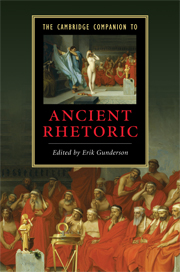Book contents
- Frontmatter
- Introduction
- Part 1 An archaeology of rhetoric
- Part II The field of language
- 4 Divisions of speech
- 5 Rhetoric, aesthetics, and the voice
- 6 The rhetoric of rhetorical theory
- 7 The politics of rhetorical education
- Part III The practice of rhetoric
- Part IV Epilogoues
- Appendix 1: Rhetorical terms
- Appendix 2: Authors and prominent individuals
- References
- Index of passages
- Index of subjects
- Series list
6 - The rhetoric of rhetorical theory
from Part II - The field of language
Published online by Cambridge University Press: 28 January 2010
- Frontmatter
- Introduction
- Part 1 An archaeology of rhetoric
- Part II The field of language
- 4 Divisions of speech
- 5 Rhetoric, aesthetics, and the voice
- 6 The rhetoric of rhetorical theory
- 7 The politics of rhetorical education
- Part III The practice of rhetoric
- Part IV Epilogoues
- Appendix 1: Rhetorical terms
- Appendix 2: Authors and prominent individuals
- References
- Index of passages
- Index of subjects
- Series list
Summary
Theories regularly enjoy a specific rhetorical advantage: their audience generally comes to them pre-persuaded that theoretical accounts are authoritative and that well-articulated theory has a masterful tale to tell about practice. For a writer of an overview of a subject, this disposition makes for lighter labors. Neutral, factual, true: an objective account of practice persuades us that theory itself is to be trusted.
It is clear, though, that I am here to put you on your guard, even at my own expense as the authoritative authority. For I am here to persuade you that theory persuades. Specifically, there is no such thing as “The theory of rhetoric.” Instead there are various performances that have been labeled by their authors as “The theory of rhetoric.” And these performances, to the extent that they are effective, yield a conviction on the part of their audience that the theory they encounter is “The Theory,” that the author of this theory is an authority, and, most importantly, that the prestigious, potent, and culturally contested domain of rhetorical practice has been fully compassed by it.
If we look at Quintilian’s Institutes we will find a text that is explicitly rhetorical. The contents of the arguments are exemplified by the form in which they are presented. It is, then, important to read the Institutio Oratoria as a rhetorical performance if we are to appreciate the message of the Institutes itself. As a rhetorical performance the Institutes betrays traits of deliberative, forensic, and display oratory since it not only concerns itself with the expedient, the just, and the noble but even attempts to unite them.
- Type
- Chapter
- Information
- The Cambridge Companion to Ancient Rhetoric , pp. 109 - 125Publisher: Cambridge University PressPrint publication year: 2009
- 6
- Cited by



